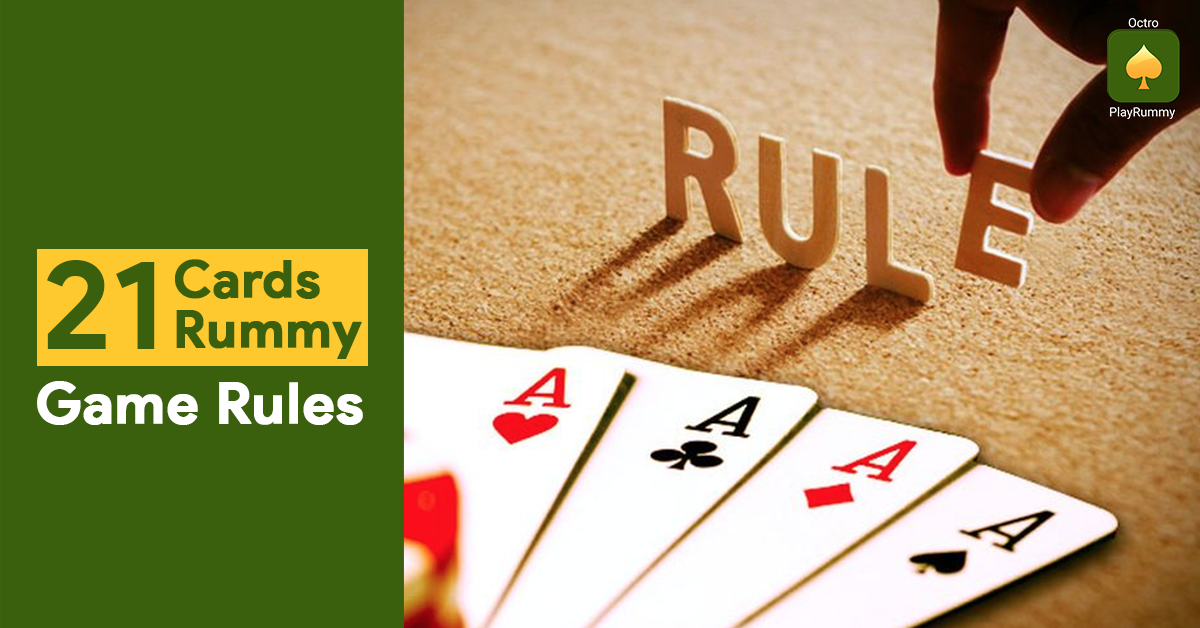
The 21 Card Rummy is played with the Point Rummy variant. The number of players required to play this rummy card game in India is between 2 to 6. According to the 21-card rummy rules, this game is played with three decks of cards and makes use of an extra group of Up & Down Jokers apart from the standard set of Printed and Wildcard jokers. Before playing the game, it is important to know the terminologies that are used in this game along with its rules.
Terminologies & 21 Card Rummy Game Rules
Upper Joker: The card which is a rank above the wild card Joker and is of the same suit as the wild card Joker is termed as the Upper Joker. For example, 7♥ will be the Upper Joker if 6♥ is the wild card Joker.
Lower Joker: The card which is a rank below the wild card Joker and is of the same suit as the wild card Joker is termed as the Lower Joker. For example, 5♥ will be the Lower Joker if 6♥ is the wild card Joker.
Note: The Upper and Lower jokers can also be used in place of any other card to form a sequence or a set. Wild card joker can also be part of a pure sequence for example 2♥ 3♥ 4♥ is a pure sequence, where three of heart (3♥) is a joker, yet it’s a pure sequence.
Example 1: In case an Ace of club (A♣) is picked as the Wild Card Joker Then (K♣) will be the lower joker and (2♣) will be the upper joker. Though, it has to be kept in mind that a sequence of K-A-2 is not a valid one even if Ace is a Joker.
Example 2: In case a Printed Joker is picked as the Wild Card Joker then all Aces (A♠ A♥ A♣ A♦) will be considered as Wild Card Jokers. In such a scenario K♠ will be lower and 2♠ will be upper joker (as ♠ is considered to be the highest suit)
Tunnela or London: A group of three identical cards of the same value and same suit is termed as a Tunnela or London in 21 Card Rummy. An example of this would be 6♥ 6♥ 6♥
A Tunnela or London is a valid one when it’s formed out of three Printed Jokers grouped together. Two identical cards with a joker is not a valid Tunnela or London. Example – 6♦ 6♦ K♦ (where K♦ is a joker), a Joker can’t be used to make a Tunnela.
Dublee: Two identical cards of the same value paired together is termed as a Dublee in the 21-card rummy and an example of this would be 4♥ 4♥.
Note: A valid Dublee can also be formed with two printed jokers grouped together. One card plus a joker, such as 6♦ K♦ (where K♦ is a joker), is an invalid Dublee. Joker can’t be used to make a Dublee, unless used as a regular card and not a Joker, example. K♦ K♦ (here K♦ is a joker yet it’s a valid Dublee).
Value Cards: Same suit cards that are upper and lower to the wild card joker are known as value cards. Same value and same suit cards as the one picked randomly as wild card joker are termed as value cards. A card higher to this selected card and a card lower is also considered as Value Cards and will have the same attribute as Joker and thus be referred to as Upper Joker and Lower Joker respectively. Also, all the three Value Cards (8♣ 9♣ 10♣ – here 9♣ was the randomly picked wild card joker) For example: If 9♣ is the wild card joker then 10♣ will be upper joker and 8♣ will be lower joker. These 3 cards (8♣ 9♣ 10♣) are value cards.
How This Game Is Played?
It’s played with 3 decks of 53 cards each including 3 printed jokers.
Here we have upper and lower joker as explained above.
It’s played like the traditional rummy game keeping in mind the standard gameplay of picking and discarding cards but this form also includes concepts like Dublee, Tunnela, upper and lower jokers along with printed jokers.
Declaration
A player has to declare at least (3) pure sequences (minimum of 3 cards or above) and the rest of the cards arranged in sets or sequences. Tunnela is also treated as a pure sequence.
A player has to declare at least (3) Tunnelas- the remaining cards need not be arranged in any order; these remaining cards need not be grouped or can be clubbed in a single group.
A player has to declare at least (8) Dublees- the rest of the cards need not be arranged in any order. Each pair of Dublees should be arranged in individual groups during declaration.
A player has to declare (8) jokers in a single group- the rest of the cards need not be arranged in any order. All the jokers should be arranged in one group during declaration.
Point Calculation Table
Value Cards Points 1 Card 2 Cards 3 Cards
Same Suit Joker 10 30 50
Upper Joker 10 30 50
Lower Joker 10 30 50
Point Calculation for Marriage or Jackpot
1 Upper + 1 Same Suit + 1 Lower = 100 points
2 Upper + 2 Same Suit + 2 Lower = 300 points
3 Upper + 3 Same Suit + 3 Lower = 500 points
Points Calculations for Various Combination of Value Cards
2 Upper Jokers – 30 Points
1 Upper Joker, 1 Lower Joker – 20 points
2 Upper Jokers, 1 Lower Joker – 40 points
2 Same Suit Joker, 2 Lower Jokers – 60 points
Calculation of Drop Points
These are those points that a player loses in the game. The table below shows the number of points that a player loses when he/she drops followed by an example.
Drop Points 21 Card
First drop 40
Middle drop 80
Maximum points earned (without value cards) 160
Maximum points with value cards 300
Maximum points lost in a wrong show 120
Scenario Where Player Loses 2 Points
A player will lose only 2 points if all the cards are arranged in valid sets and sequences including 3 mandatory pure sequences. Player will only 2 points if he has grouped 6 or more Dublees and if each of those Dublees are grouped separately. Player will lose just 2 points if he has 7 or more jokers and if all those jokers are grouped together separately from other cards.











